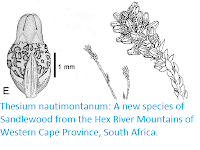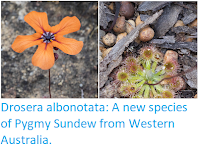Water Willows, Justicia, are perennial herbs and shrubs found in tropical, sub-tropical, and warm temperate regions of the Americas, Africa and India. They typically have heavily veined leaves and white, cream, yellow, orange, or pink tubular flowers, which are attractive to Butterflies, making them widely cultivated as ornamental flowers, though they are not hardy and need to be kept under glass in areas prone to frosts. The genus Justicia is the largest in the family Acanthaceae, and was recently expanded to include the genus Monechma, after that genus was found to contain plants which were morphologically similar to one-another but not genetically monophyletic (i.e. not all sharing a common ancestor which isn't also the ancestor of other plants which are not placed within the genus), and it is likely that other genera will also be subsumed by Justicia in the future.
In a paper published in the journal Blumea on 3 May 2019, Iain Darbyshire of the Royal Botanic Gardens at Kew, and David Goyder of the National Geographic Okavango Wilderness Project at the Wild Bird Trust, describe two new species of Justica from southern Angola.
The first new species is named Justicia cubangensis, meaning 'from Cubanga' in reference to the Cubango River drainage, where it was discovered, part of the upper catchment of the Okavango system in Angola. This plant forms erect or trailing perennial herbs, 15-65 cm high, with annual branching stems arising from a woody base. The stems are quadrangular and hairy, the leaves lance shaped and up to 46 mm in length. Flowers are born on a spike 25-70 mm long and are 12–13 mm long and cream-white in colour, with the palate of the lower lip pink with white veins in raised ‘herring-bone’ pattern. The species was found in Cuando Cubango and Huíla provinces, growing in open grasslands within areas of Miombo (flood-plain) woodland. It was observed at only three locations, and was not abundant at any of these, but may be more widespread as Angola has been under-explored by botanists to date.
Justicia cubangensis. David Goyder in Darbyshire & Goyder (2019).
The second new species described is named Justicia eriniae, in honour of Erin Tripp of the Museum of Natural History at the University of Colorado, who collected the first specimen of this species. This is a brittle-stemmed herb reaching 50-75 cm in height, which has blade-shaped leaves up to 65 mm in length. and produces tubular flowers 18-18.5 mm in length on a flower spike 5.5-8.0 cm high. A single patch of these plants, less than 10 in number, was found growing by a road in Namibe Province, southwest Angola, in an area of lowland thornscrub, though it is unclear if this means the species is rare, since the area is poorly explored.
Justicia eriniae. David Goyder in Darbyshire & Goyder (2019).
See also...
Follow Sciency Thoughts on Facebook.








